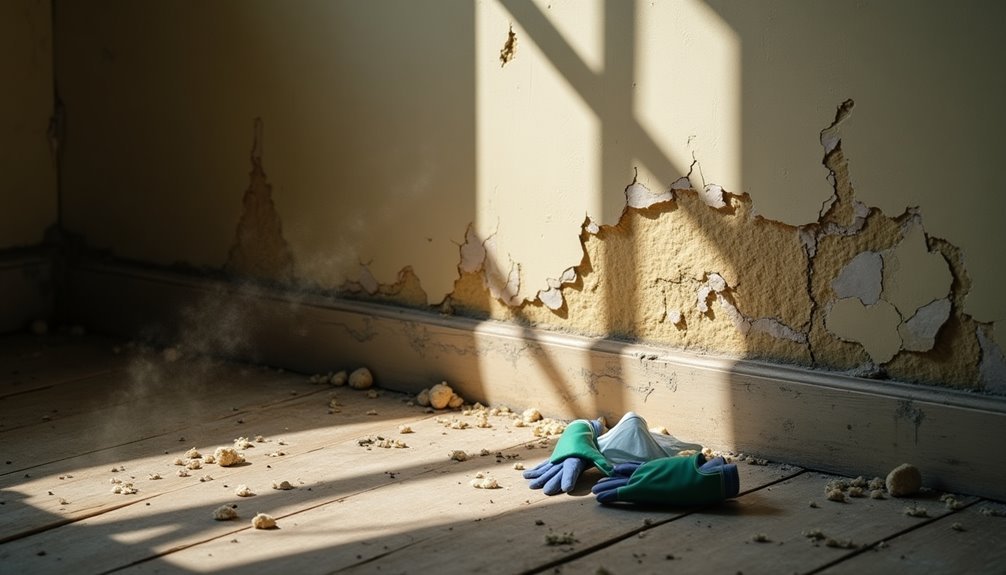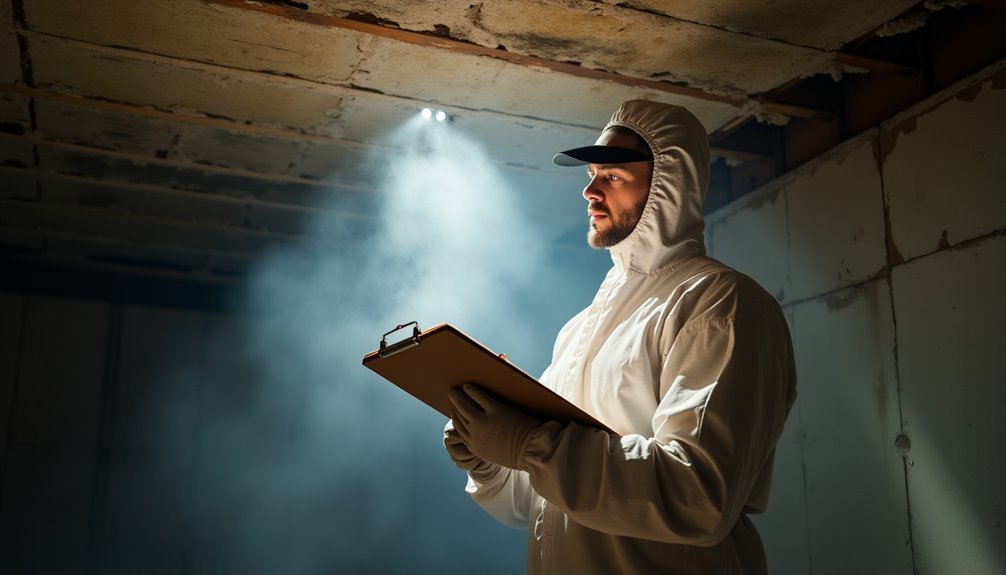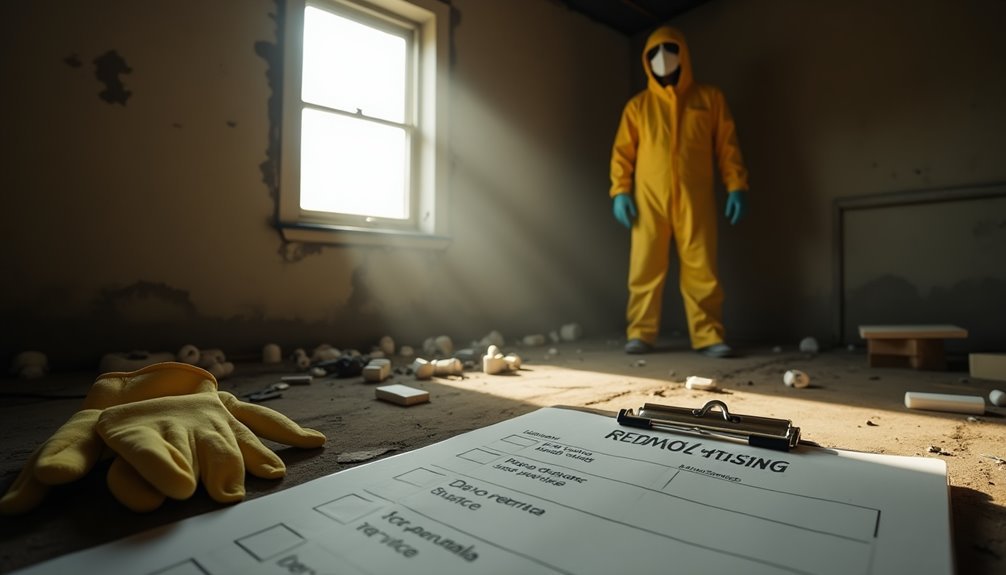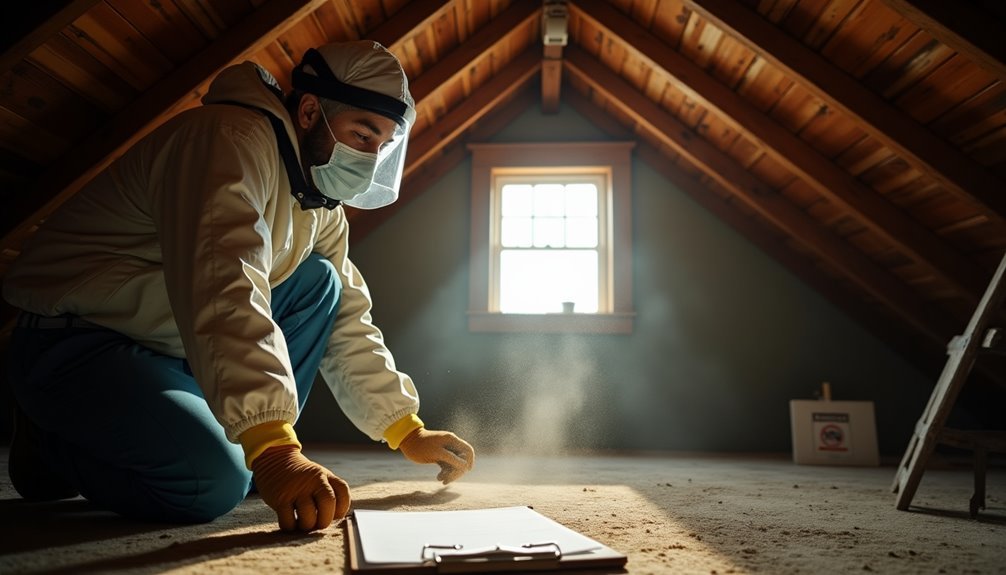Asbestos inspections are vital for safeguarding your home and health. Exposure to asbestos can lead to serious diseases like lung cancer and mesothelioma, often showing symptoms decades later. In older buildings, professional inspectors identify potential asbestos-containing materials through thorough assessments. These experts use strict safety protocols, ensuring that harmful fibers aren't disturbed during inspections. Investing in these inspections not only protects your well-being but can also enhance your property's value by affirming its safety. By understanding the risks and inspection processes, you can take informed steps to maintain a healthier living environment. Discover the full scope of asbestos-related challenges next.
Historical Use of Asbestos

Historically, asbestos has frequently been recognized for its remarkable properties, which led to its widespread use across various cultures and industries. As early as 4,500 years ago, ancient Greeks utilized asbestos applications to create fire-resistant textiles, including cloaks and theater curtains. Similarly, in Egypt, pharaohs were wrapped in asbestos cloth for embalming, highlighting its historical significance in preserving the dead. Meanwhile, in Finland, artisans strengthened clay pottery with asbestos around 2500 B.C., showcasing its diverse utility.
The modern era saw a surge in asbestos applications, particularly during the Industrial Revolution. By the early 1800s, Italy kickstarted the asbestos industry, focusing on textile manufacturing. Innovations, such as the Hatschek process in 1907, enabled mass production of fireproof building materials. Asbestos became integral to insulation for steam pipes and boilers, while firefighters donned protective clothing made from this resilient mineral. Asbestos insulation became the primary exposure source as the 20th century unfolded, asbestos continued to dominate various sectors, including construction and automotive industries. Its historical significance is evident in its widespread application, which shaped industrial practices and influenced safety standards for generations. Understanding this history is essential for recognizing the ongoing need for asbestos inspections today.
Health Risks of Asbestos
The extensive historical use of asbestos in various industries has significant implications for public health today. As you assess your environment, it's crucial to recognize that asbestos exposure substantially increases the risk of serious diseases, including lung cancer, mesothelioma, and asbestosis. Inhaling microscopic asbestos fibers can lead to inflammation and scarring in lung tissue, resulting in long-term health consequences. Furthermore, all asbestos fibers are harmful if breathed, making it essential to treat any potential asbestos exposure seriously.
Asbestos symptoms often don't manifest until decades later, sometimes taking 20 to 50 years to develop. Early signs may include coughing and shortness of breath, which can easily be mistaken for less severe conditions. This delay underscores the importance of risk assessment in environments where asbestos may still reside.
Furthermore, individuals exposed to asbestos, particularly those in older homes or industries that historically used the material, should be vigilant. The combination of smoking and asbestos exposure significantly heightens the risk of lung cancer, while other cancers, including those of the digestive system, have also been linked. By understanding these risks, you can take proactive steps to protect your health and seek necessary inspections or remediation.
Need for Professional Inspections

Understanding the critical need for professional asbestos inspections can significantly impact your health and safety. The inspection necessity arises from the dangers posed by asbestos, which can be present in many homes, particularly in older structures. Certified inspectors bring specialized training and expertise, enabling them to identify and collect samples from suspected asbestos-containing materials accurately. They utilize specialized tools that minimize disturbance to asbestos fibers, ensuring a safe inspection process.
During an expert evaluation, inspectors conduct a thorough visual examination of areas prone to asbestos, such as insulation and flooring. They collect samples in a manner that safeguards both themselves and your living environment. Laboratory analysis is crucial for confirming the presence and concentration of asbestos, as these fibers are microscopic and invisible to the naked eye.
The written evaluation you receive will detail the location and extent of any asbestos found, along with actionable recommendations for safe management or removal. This comprehensive assessment not only supports your safety but also complies with legal guidelines, providing peace of mind in your home. Prioritizing professional inspections is a vital step toward protecting yourself and your family from the risks associated with asbestos.
Asbestos Testing Process
When you initiate the asbestos testing process, preparation is key to ensuring accurate results. Certified inspectors carefully collect samples from suspected areas using specialized techniques that minimize disturbance to the fibers. Once collected, these samples undergo rigorous laboratory analysis to identify and classify any asbestos present, guiding you toward informed decisions about your environment's safety.
Inspection Preparation Steps
Preparing for an asbestos inspection involves several critical steps to ensure a smooth and efficient process. You'll want to start by hiring a certified inspection company and confirming the date and time of the inspection. Discuss the scope with them, including which areas need assessment, and ask for specific preparation tips tailored to your property.
Here's a helpful inspection checklist to guide your preparation:
| Task | Description |
|---|---|
| Clear Spaces | Remove personal items and ensure unobstructed access. |
| Access Hard-to-Reach Areas | Provide easy access to attics, basements, and crawl spaces. |
| Avoid Disturbing Materials | Don't disturb potential asbestos-containing materials. |
| Follow Containment Guidelines | Adhere to any recommendations from the inspection company. |
| Turn Off HVAC Systems | Prevent fiber circulation during the inspection. |
Sample Collection Techniques
Utilizing effective sample collection techniques is crucial in the asbestos testing process to ensure accurate results and maintain safety. You should focus on common areas where asbestos-containing materials, like insulation and flooring, are likely found. For textured surfaces, such as popcorn ceilings, it's essential to collect multiple samples from different locations if the texture was applied at varying times.
Adhering to established collection protocols is vital. Use specialized tools to gather samples without disturbing fibers, and wear protective clothing, including respirators, to safeguard against exposure. Employ wet-wipe methods with soapy water during the process to minimize airborne dust.
Your sampling methods should include obtaining representative samples—preferably three—from each location to avoid cross-contamination. For air sampling, a filter with a specific membrane is employed, and flow rates should be adjusted according to the environment. Remember, proper handling and shipment of samples are equally important. Package samples carefully to prevent damage, include field blanks for integrity checks, and ensure all samples are correctly labeled for laboratory analysis. Following these techniques not only protects your health but also contributes to reliable asbestos testing outcomes.
Laboratory Analysis Procedure
After collecting samples, the next step is conducting laboratory analysis to accurately identify the presence of asbestos. This process occurs in a controlled laboratory setting with negative pressure dust cabinets and HEPA filters to ensure safety. Only UKAS accredited laboratories conduct this analysis, with P401 qualified analysts handling the samples.
Initially, analysts open the samples in a dust cabinet and place them in disposable petri dishes for examination using stereomicroscopy. This analysis technique allows for a three-dimensional view, enabling the identification of fibres based on their physical properties. Analysts then select the appropriate refractive index (RI) liquid for further analysis.
Next, Polarised Light Microscopy (PLM) is employed. Analysts mount the suspect fibres in RI liquid, covering them with a coverslip. They examine the samples for specific characteristics, including morphology and pleochroism, confirming the type of asbestos present.
For more detailed analysis, Transmission Electron Microscopy (TEM) can be used, especially for air samples. The lab compiles a comprehensive report detailing the areas tested, types of asbestos, and percentage composition. Results typically take a few days to a week, ensuring you receive timely information for your safety.
Actions After Detection

Once asbestos is detected, immediate and systematic actions are essential to ensure safety and compliance. You need to act swiftly to prevent further exposure and safeguard your health. Here's a structured approach to follow:
- Containment and Preparation: Seal off the work area with plastic sheeting and negative air pressure machines to prevent the spread of asbestos fibers. Ensure air ducts are sealed, and the HVAC system is disabled.
- Removal or Encapsulation: Trained professionals should use specialized tools and wet methods for asbestos removal or employ encapsulation methods to seal materials and prevent fiber release.
- Cleaning and Clearance: After the abatement process, a thorough cleaning with HEPA vacuums is crucial. Conduct air quality testing to confirm that levels are below safe limits.
- Disposal and Reporting: Dispose of asbestos waste in licensed landfills according to regulations. Generate a comprehensive report detailing the findings and recommendations for future actions.
Statistics on Asbestos Impact
Asbestos, a once widely used material, has left a devastating legacy marked by alarming statistics on its impact on health. Each year, nearly 1,300 Americans die from asbestos-related diseases, a grim reminder of the material's persistence. Globally, over 200,000 deaths are attributed to occupational exposure annually, highlighting the urgent need for effective asbestos regulations. Between 1979 and 2001, over 43,000 Americans succumbed to mesothelioma and asbestosis, and the CDC anticipates nearly 30,000 more lives lost from 2005 to 2027.
Despite strict controls initiated in the 1980s, approximately 1.3 million American workers still face exposure today. Even small amounts of asbestos can trigger severe conditions like mesothelioma, and second-hand exposure can affect families. Shockingly, asbestos accounts for over 70% of work-related cancer deaths worldwide.
As you seek liberation from this threat, consider seeking asbestos alternatives in construction and renovation. Awareness and proactive measures can help mitigate these risks, ensuring a safer environment for yourself and future generations. The statistics are clear: understanding the impact of asbestos is crucial for protecting your health and advocating for change.
Protecting Your Home and Health

Understanding the health risks associated with asbestos is crucial for your safety and well-being. By opting for professional inspections, you can identify potential hazards and implement effective management practices to protect your home. Awareness and proactive measures will help you minimize exposure and ensure a healthier living environment.
Health Risks Awareness
Awareness of the health risks associated with asbestos exposure is crucial for protecting your home and well-being. Many people cling to asbestos myths and health misconceptions, underestimating the dangers lurking in their environments. Understanding the real risks can empower you to take necessary precautions.
Consider these key health risks linked to asbestos exposure:
- Asbestos exposure can lead to serious cancers, including lung, larynx, and ovarian cancers, as well as mesothelioma.
- Inhalation of asbestos fibers can cause lung scarring, leading to permanent loss of lung function.
- Chronic respiratory diseases, such as asbestosis, can develop over time, sometimes with little warning.
- Co-exposure to tobacco smoke significantly amplifies the risk of developing lung cancer.
The latency period of asbestos-related diseases can be decades long, meaning symptoms may not appear until it's too late. By educating yourself on these risks, you can debunk the myths that downplay asbestos dangers and take proactive measures to ensure your home is safe. Don't let ignorance compromise your health—staying informed is your first step toward liberation from these threats.
Professional Inspection Benefits
Recognizing the health risks tied to asbestos exposure underscores the importance of professional inspections in safeguarding your home and health. By engaging experts with professional expertise, you gain significant inspection advantages, including accurate identification of asbestos-containing materials. Trained professionals perform thorough visual inspections of all accessible areas, taking samples for laboratory analysis to confirm asbestos presence. Their knowledge ensures that even hidden dangers are detected.
These experts provide a comprehensive assessment and detailed report outlining the exact location and extent of asbestos, along with tailored recommendations for safe removal. This documentation not only guides removal teams effectively but also adds value to your property by demonstrating it's asbestos-free.
Moreover, safety is paramount during inspections. Professionals follow strict protocols, including isolating areas and turning off HVAC systems to prevent airborne fibers. You can rest assured that inspectors prioritize your safety and take necessary precautions.
Ultimately, investing in professional inspections means protecting your family's health and enhancing your property's marketability. By identifying and addressing asbestos risks proactively, you secure peace of mind and contribute to a healthier living environment for years to come.
Safe Management Practices
When managing asbestos in your home, implementing safe practices is crucial for protecting both your health and property. Adhering to strict asbestos containment protocols ensures that the hazardous material is managed effectively, reducing the risk of exposure. Here are some key practices to follow:
- Prepare the work area: Erect barriers and signage to restrict access, minimizing unauthorized entry.
- Use proper PPE: Equip yourself and workers with respirators, gloves, and coveralls that meet PPE standards for asbestos handling.
- Implement wet removal methods: Saturate asbestos-containing materials to prevent fiber release during removal.
- Establish decontamination zones: Designate clean and dirty areas with appropriate facilities for washing and disposing of contaminated clothing.
Following these guidelines not only protects your health but also safeguards your home from potential asbestos contamination. Remember, proper training and understanding of emergency procedures are vital during this process. By prioritizing safety and adhering to established protocols, you can effectively manage asbestos risks while ensuring a safer environment for everyone involved.
Conclusion
In summary, taking a proactive approach to asbestos inspections is essential for ensuring your home remains a safe haven. By addressing potential concerns with a professional touch, you can safeguard your health and your family's well-being. Remember, a little vigilance today can prevent significant headaches tomorrow. So, don't overlook the importance of these inspections; your peace of mind and a healthier environment are worth the effort. After all, it's better to be safe than sorry!
